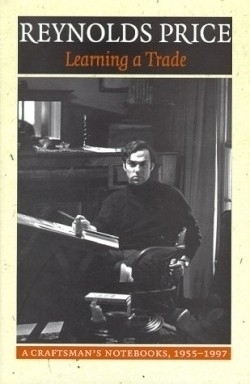Learning a Trade
A Craftsman's Notebooks 1955-1997
In the rich autumn of Reynolds Price’s voluminous career, or on page 514 under the June, 1990 entry of his own 42 years of journal keeping now published as Learning a Trade: A Craftsman’s Notebooks, 1955-1997, he notes with characteristic acuity as he jots the plot of his next novel on the back of an envelope: “a well-tended unconscious mind will invent one’s work and deliver it.” It is an aplomb worthy of Edith Wharton, if not Henry James, a faith in the redemption by the imagination that, in the North Carolina world he has lived in and recreated in his novels, seems untainted by the modern self-doubt of the European example. Indeed, Reynolds Price (much like his beloved Eudora Welty) affirms that the imagination is fluent in the local vernacular. And it is the nature of inspiration, the writer’s breath that brings to life the studio’s clay figures, that informs this volume: a rare glimpse into the artist’s studio, from his days as a callow Milton scholar in search of an authorial voice in the Eisenhower era, to a 1997 reading of his last novel, Roxanna Slade, to his creative writing students at Duke University where he has taught English since 1958.
Divided into chapters called by each of his 30 published works, the journals are most absorbing if you are already on first name basis with his novels’ namesakes. It is curious, even moving, to see his first meditations on the narrative voice that becomes Kate Vaiden, easily his most popular novel. But the sense of discovery that he plots in each of his novels tends to become monotonous, since Mr. Price has cut his reflections to the bone and the unbuttoned writer who might make personal or professional excursions is seldom seen. In the hypnotic lull of his musing, combing the phone directories for a resonate name, for example, his storytelling manner gracefully conceals his labor. This is not a man wrestling his Muse to the ground to acquire her blessing, rather, it is offering southern hospitality to her, so that she returns the favor by murmuring in response, “No, she was older than your mother,” or, “Wasn’t that Bess Walters’ girl you went to school with?” Unpacking his carpetbag of plot devices, the suicides, abortions, teen marriage, runaway child motifs he frequently replays, he worries with cause, “Is this too easy spinning?” Mr. Price seems a genuinely nice man. But journal writing is a tricky mirror writing, and in its confessional a second mirror of the novels themselves is needed to sharpen the focus. Here, he offers in a rare move a public, formal posture of the writer at work. While not fiction, it is certainly selective. The craftiness that lives in any writer’s craft is elicited. Perhaps it’s just as well, for that is the one trick that can’t be taught, only discovered within.
Reviewed by
Leeta Taylor
Disclosure: This article is not an endorsement, but a review. The publisher of this book provided free copies of the book to have their book reviewed by a professional reviewer. No fee was paid by the publisher for this review. Foreword Reviews only recommends books that we love. Foreword Magazine, Inc. is disclosing this in accordance with the Federal Trade Commission’s 16 CFR, Part 255.

